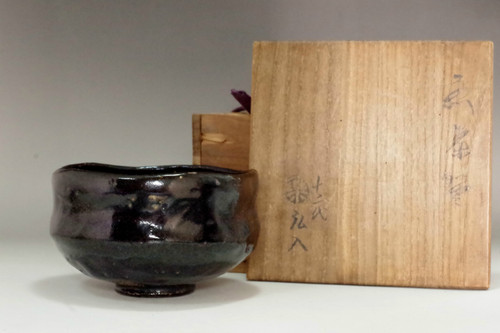12th Raku Konyu (1857-1932) Antique kuro-raku tea bowl #4200
- SKU:
- 4200
- Shipping:
- Free Shipping
- width: approx. 11.5cm (4 17⁄32in)
- height: approx. 6.9cm (2 23⁄32in)
- weight: 257g (gross 502g)
The Twelveth Raku - konyu (1857-1932)
Born as the first son of Keinyu, Raku the 11th. Inherits the family estate at age 15, passes the estate to his eldest son Seinyu at age 63 and retires. He dies at age 76. Konyu is said to have had a mild temperament and exerted all his effort for the survival of the Raku family. He enjoyed poem, and led a secluded life at the summer house in Ishiyama in Shiga Prefecture, indulged in art as he created potteries. He has left many poems such as "as I play around with soil, my 76th autumn arrives", "time has come and the Tsurushi-gaki (dried persimmon) has changed form" (at the day when take the tonsure). All of which conveys his honest feelings, the scenery of the Omikonan, and the simple and good-natured character of the old Konyu. Konyu, like his father Keinyu, grew up at a time after the Meiji restoration period when the tea ceremony was in decline, and thus, must have struggled in his twenties when there were few demands for tea bowls made by the Raku family. Reflecting such realities, Konyu only started to produce his products when he was around 25 years old. In Meiji 23, when he was 34 years old, he created 300 red tea bowls with his father Keinyu on the 300th anniversary of Chojiro's death. It seems like from that point forwards, the tea ceremonies seem to have gained renewed energy. Konyu started to produce many pieces, and this did not slow down after he retired, and thus he has many works under his belt. His style did not change throughout his life, but he has been inspired by Ryonyu the 9th in his use of a spatula and has made it his own by showing different ways to show off the spatula technique. He has created many round and soft pieces and has uniquely carved in the spatula technique. Due to the decline of tea ceremonies, the tea bowls are overall quite small. He uses the glossy black Raku glaze and the makuyu glaze (curtain glaze), there is a white Jakatsuyu (snake's scale glaze) peaks out at the end of the makuyu glaze. Additionally, a transparent yellowish glaze called the "Kihageyu (yellow bold glaze)" is also used, and a technique which scatters several symbols called "Su-in" is used, elevating the design of the work. The red Raku glaze is interesting in that the work changes in the oven through oxidization and reduction. In the period of Kichizaemon, a raku-in called "Hachiraku-in" by Ishikawa Jozan, it was made at the same time he created the 300 tea bowls with his father when he was 34 years old on the 300th anniversary of Chojiro's death, and at this time, the 11th Omotesenke Rokurokusai’s raku-in used calligraphy, and after his retirement, in Tokugawa Yorimichi’s “Inkyo-in”, others, asked by Fushiminomiya he used Fushiminomiya Sadanaru Shinno’s raku-in and also used “Gyoka-in” which was a hairyo-in from the Nishi-honganji. His works include, “Juga” which is a black raku teacup with a picture of the crescent moon which was a gift for his wife, “Kihai” and “Momijinonishiki” which are red raku teacups created for the 300th anniversary for Chojiro’s death.
















